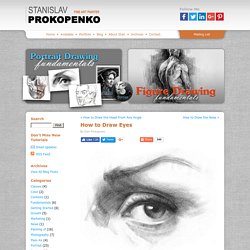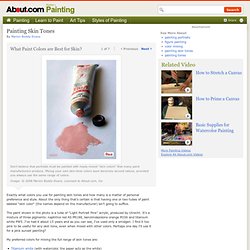

Behance Network. DIVAS AND DREAMS. ARTNATOMY/ARTNATOMIA. Color Mixing Guide. How to Draw Eyes. For a video version of this tutorial visit www.proko.com/how-to-draw-eyes-structure This tutorial is a continuation of How to Draw the Head from Any Angle.

I will go over the structure of the eye and detailed information on drawing the brow ridge, eyeball, eyelids, eyelashes, iris, cornea, and pupil. The Basic Forms The Eyeball The part of the eyeball that is visible (technical term is Sclera) is commonly called the ‘white of the eye’. The biggest mistake you can make is to leave the ‘white of the eye’ white, when the entire eye is in shadow. The Iris, Cornea, and Pupil Structure of the Iris and Cornea The Pupil It’s important to remember that the pupil is on the iris, not the cornea. Shading the Iris, Cornea, and Pupil Understanding the structure of these forms is important for when you start shading them.
The Eyelids Eyelids Are Not Flat Also, the lids have some thickness to them, so showing the bottom plane of the top lid and the top plane of the bottom lid is very important. Eyelashes. How to Paint Skin Tones. Exactly what colors you use for painting skin tones and how many is a matter of personal preference and style.

About the only thing that's certain is that having one or two tubes of paint labeled "skin color" (the names depend on the manufacturer) isn't going to suffice. The paint shown in the photo is a tube of "Light Portrait Pink" acrylic, produced by Utrecht. It's a mixture of three pigments: naphthol red AS PR188, benzimdazolone orange PO36 and titanium white PW5. I've had it about 15 years and as you can see, I've used only a smidgen. I find it too pink to be useful for any skin tone, even when mixed with other colors. My preferred colors for mixing the full range of skin tones are: Titanium white (with watercolor, the paper acts as the white) Titanium buff Cadmium yellow (medium or dark) Cadmium red Burnt sienna Raw umber Prussian blue Payne's grey (not essential, but useful) If you don't like using cadmium pigments, substitute whichever red and yellow is your favorite.
Richard Schmid - Sequential Sketches and Other Delights (2006) Richard Schmid - Sequential Sketches and Other Delights (2006) DVD5 | MPEG2 @ 6 Mbit/s | 720x480 | AC3 Stereo @ 192 Kbit/s 48 KHz | 1.86 GBGenre: Painting, Education, Instructional | Label: RichardSchmid.com | Language: English | Subtitle: None.

50 Clever Tutorials and Techniques on Traditional Drawing - Smashing Magazine. Advertisement Traditional drawing is certainly way harder than digital and it is true that people are able to progress much faster digitally, but one should learn the traditional type of drawing and painting before starting digital drawing, since it often lays out the foundation for screen design.

This article contains a mixture of traditional drawing tutorials, drawing techniques and some methods for transforming and preparing your creations for screen design. Some are intermediate level and some are advanced tutorials that include general theory, useful tips, comic inspired art, sketch a pencil drawing, coloring processing, character sketching, shapes, proportional, perspective and much more. We hope that drawing tutorials and techniques in this post will be a great help to you. Traditional Drawing Tutorials Marilyn Portrait TutorialA truly fantastic drawing tutorial to learn how to draw a portrait of Marilyn Monroe with pencil. Traditional Drawing Tips & Techniques It's done. Home.